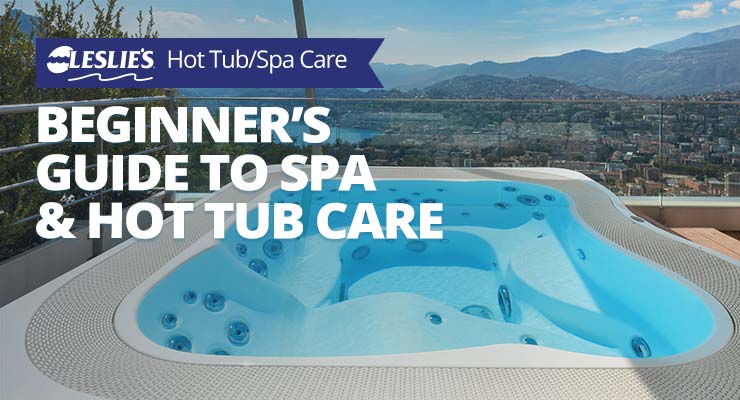
Beginner's Guide to Spa & Hot Tub Care
For the new spa owner, or for someone who is new to hot tub maintenance, we have a few easy tips to help you care for your spa. These simple maintenance and cleaning tasks will keep your water crystal clear, sanitary and ready to use. Keep reading to learn the five easy steps to maintain proper water chemistry, how to clean a hot tub, and keep your spa equipment in top shape:

Test your water balance 2–4 times per week. Adjust water balance with the appropriate hot tub chemicals.
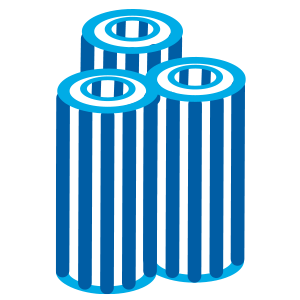
Clean the spa filter every 1–2 weeks, and replace annually.
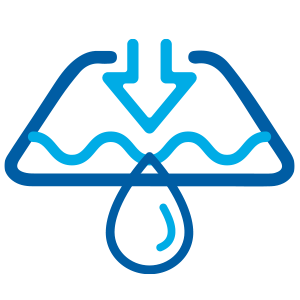
Keep the spa clean; drain and refill every 3–4 months.

Air out the spa cover twice per week.

Add water as needed to keep the spa full.
Keep Up with Water Chemistry
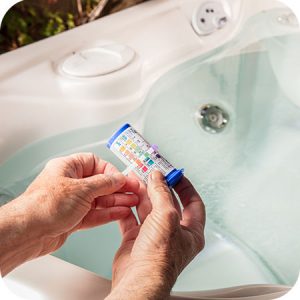
The secret of hot tub care and cleaner water is to test the water! Use these results and make small adjustments to pH, alkalinity, calcium hardness and sanitizer levels regularly. This means testing the spa water 2–4 times per week and adjusting levels as needed to keep the water balanced within the proper ranges:
- Chlorine: 1.0–3.0 ppm
- Bromine: 2.0–4.0 ppm
- pH: 7.4–7.6
- Total Alkalinity: 80–120 ppm
- Calcium Hardness: 150–250 ppm
If you’re looking for the most accurate test results, you can bring a water sample to your local Leslie’s for a free comprehensive AccuBlue® water test and customized treatment plan. Use these results as a guide to treat and balance your spa water.
Keeping a water test log is a good idea to track your test results and make notes on adjustments. In many cases, you'll start to notice patterns in water chemistry, especially with pH and sanitizer levels.
Tap water is good spa water in most areas. But in some areas (you know where you are), you may run into water quality issues. Soft or hard water, high alkalinity, pH imbalance, and high levels of chloramines, metals or minerals can all negatively impact water balance in your hot tub. Use a test kit to sample your tap water directly from the source or after a drain and refill. This will help you gauge the suitability of your tap water for use in the spa. Using a spa pre-filter removes metals, odors and the finest silt from your spa fill water.
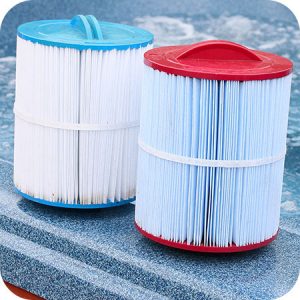
Clean the Spa Filter
The spa filter is usually under the skimmer basket and can be accessed from the side of the spa, or it can be a small tank assembly that is opened up underneath the spa. You'll need to locate it first in order to clean or replace the filter during your spa and hot tub care routine. If it's underneath the spa, there should be a closable valve that helps prevent water from rushing out when you open the filter. Loosening a large nut or just turning the filter body counter clockwise is the usual method to access the filter cartridge. Some water spillage is inevitable when opening it up. But if done carefully, this will be very little.
If your spa filter has a pressure gauge attached to it, the cartridge needs cleaning when the pressure rises 8–10 PSI higher than the freshly cleaned pressure reading, or when flow is noticeably reduced. If there's no gauge on your filter, just clean the filter on a regular weekly or biweekly schedule according to manufacturer recommendations for your hot tub. Cleaning frequency depends on the size of the filter, water capacity of the hot tub, and frequency of use.
Replace your spa filter approximately every 12 months, again depending on usage. The general rule of thumb is to change it every 10–15 cleanings, because that's what really breaks down a cartridge. Every time it gets cleaned, the fibers loosen up and it loses a little bit of its dirt-trapping ability. Keep track of your spa filter's age and/or cleaning cycles, and pay attention to the filter material, because at some point it's going to wear out and be ineffective.
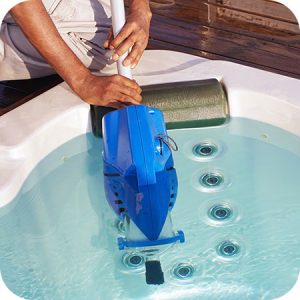
Clean the Spa
You should drain your hot tub every 3–4 months, as well as conduct a full cleaning of all surfaces, the waterline and plumbing. Just be sure to NOT use any household cleaning products or soaps. If want to use cleaning chemicals on your spa surfaces, try something like Natural Chemistry Clean & Perfect. Choose a quality cleaning product to keep out phosphates, nitrates and other contaminants that can negatively affect water quality.
For accumulated dirt and debris, vacuum seats and floors with a small vacuum made specifically for spas and hot tubs. Most are battery powered, but there are other styles available. The Pool Blaster spa vacuum is battery operated and easy to use. There's also the Grit Getter, a small manual cleaner that's perfect for picking up little grains of sand and debris that gather in the corners. The more powerful spa vacs can quickly remove even large leaves from your hot tub.
Floating debris can be removed with a simple skimmer net. If you happen to leave the cover off during a windstorm and the spa is full of leaves, a skimmer net can also be used to scoop up larger leaves under the water.
BONUS TIP: Looking for more information on spa and hot tub care? Download the Leslie's Hot Tub Maintenance Checklist for a detailed daily, weekly, monthly, quarterly, and annual list of routine spa and hot tub maintenance tasks.
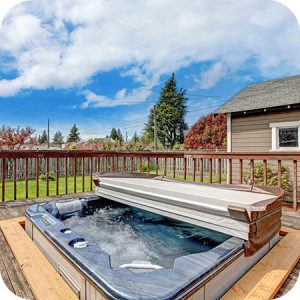
Air Out the Spa Cover
One of the most important things you can do to increase the longevity of your spa cover is to remove it at least twice per week. Use a spa cover lifter to completely remove it. If you don't have a spa cover lift, gently place it off the spa. Give your cover a few hours to breathe and get away from the constant heat and moisture. If you're not using it at the time, this is a great opportunity to add chemicals or shock the spa if needed.
Another good spa maintenance practice is cleaning and conditioning your vinyl spa cover. Especially if your spa is outside, using a spa cover cleaner can quickly remove airborne oils, dirt, tree sap and pollen. After it's clean, use a cover conditioner to replenish the vinyl plasticizers that keep your vinyl spa cover soft, strong and looking great.
Add Fill Water
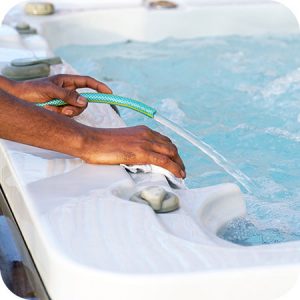
This hot tub care tip is so often forgotten. However, if the skimmer starts to suck air instead of water, it can damage the pump. The water level should be in the middle of the skimmer intake or a little higher. You don't want it too high, and you never want to overflow the spa, so keep a close eye on the water level while filling.
Keep a garden hose nearby. If your garden hose is too far away, set up a sub-spigot by running a hose from a splitter on your current spigot, to a spigot that is mounted on a stake. Then you always have a hose right next to the spa for filling or topping off the hot tub water level.
Summary
Again, to handle 95% of spa and hot tub care and maintenance tasks, just remember these five easy tips:
- Test and adjust your spa water balance 2–4 times per week.
- Clean the spa filter every 1–2 weeks, and replace annually.
- Keep the spa clean; drain and refill every 3–4 months.
- Air out the spa cover twice per week.
- Add water as needed to keep the spa full.
That's all there is to it! If you have any questions about the timing of different hot tub care tasks, or if you're looking for more tips on maintaining a hot tub correctly, check out Leslie's Hot Tub Maintenance Checklist, and download the full list to keep for future reference.